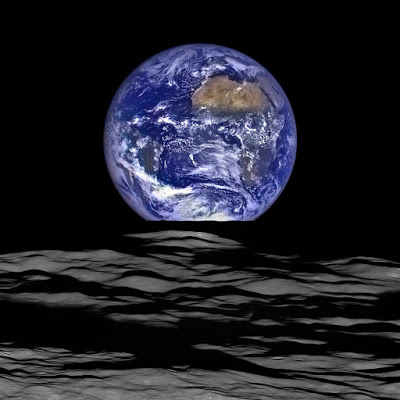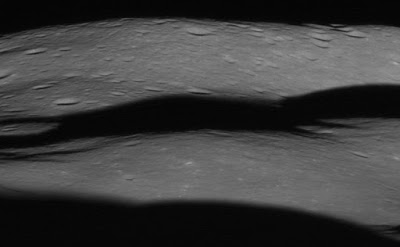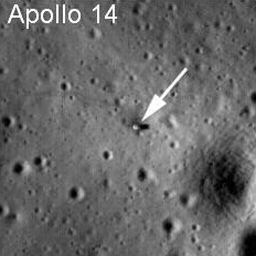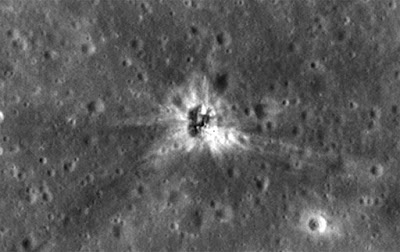Shadows of Deception

Apollo 14, NASA Archives, AS14-68-9486
(Photo toward the LM from Station H. Shepard is to the left of the spacecraft with his back to us looking in the general direction of the LM and, beyond it, Old Nameless. As per request from Houston, he is aiming the TV camera at the MESA.)
[Source: http://www.apolloarchive.com/apollo_gallery.html]
It is difficult to sustain a deception that is dependent upon current technology to create an illusion. As years pass and technology advances, the ability of the average man to detect the deception increases. When the moon missions were displayed to the world in the years 1969-1972, television recording technology had not yet reached the consumer. The Sony Betamax tape system would not be released until 1975, and VHS would not reach consumers until 1976. Even then, it would take years for video recording technology to become commonplace in homes. The television viewer in the years of the Apollo missions had no way to capture a television broadcast and play it back for careful examination.
Similarly, still images which were displayed in the newspapers and magazines of the day provided only a limited means of scrutinizing the Apollo images. Newsprint is typically black and white and low definition. Magazines offer better image quality, but there is often doubt as to whether the magazine has altered an image in some manner, or whether it is a faithful reproduction of an original image. If someone detects an anomaly in a magazine image relating to the lunar landings, NASA can argue that the image had been altered by the periodical’s editors and is not authentic.
With the advent of the Internet, and the widespread dissemination of videos on tape, disk, or in electronic format such as digital downloads, people have available to them tools for examining the Apollo Program’s material which were unknown to a previous generation. Archives of NASA’s images are available on official government sites. They can be accessed by anyone with an Internet connection, and carefully scrutinized with powerful image editing software on home computers whose processing capabilities dwarf even the largest mainframe computers of the Apollo era. This has afforded numerous individuals an opportunity to discover the telltale signs of a deception.
One of many images which provide evidence of the moon photos having been staged is displayed at the top of this post. The image is from the Apollo 14 mission which launched on January 31, 1971. If a person had no suspicions about the government faking the moon landings, they might overlook the telltale signs of the shot having been staged on Earth. Mankind tends to overlook anomalies when they are not expected. The following image is taken from “The Moon Landing Hoax” website. See if you can spot the anomaly quicker than the author of that site did. (Note: If you don’t spot the error and are losing sleep over it, e-mail me and I will help you out.)

I am sure NASA in the 1960s and 1970s did not anticipate so many individuals scrutinizing their images on powerful home computers, searching for anomalies. They could hardly have anticipated how ubiquitous computer processors would become in succeeding decades, nor were they likely to have foreseen the development of the Internet. Many individuals who contend that NASA faked the moon landings have pointed out anomalies in the shadows of the images the government assures us were taken from the lunar surface. The astronauts of the Apollo missions took no auxiliary lighting with them to aid in their photography. Nor were any of their cameras equipped with flashes. Much evidence of multiple light sources, such as that which would be used in a staged environment on Earth, has been found by examining the Apollo images.
In our Solar system, we have one primary source of light. Whether we are standing on the surface of the Earth or the surface of the Moon, the Sun which is 93 million miles away causes shadows to manifest in consistent ways. If the ground is flat, or all objects casting a shadow are on the same plane, the shadows will appear parallel to one another.

If the ground is uneven, a person will observe shadows lying at diverse angles from one another and being disproportionate in size.

Look carefully at the image above. The angle of divergence of the shadows of these two toy astronauts is quite acute. This is because the contour of the ground is similarly extreme. If you look closely you will see that the shadows of the two astronauts are falling on opposite sides of a ridge. This is an extreme case, and causes the shadows to depart greatly from one another even when the Sun is the only source of light. There are very few images from the surface of the moon that contain such extremes. What I would emphasize is that shadows behave consistently. When the Sun is the only source of light we can determine the proper angle of any shadow if we examine the context of the image and the contour of the ground.
I want to focus in on one image at this time. It is the image at the head of this chapter. If you did not notice, the shadow from the Lunar Module and the shadows from the rocks in the foreground, are not parallel. They are not even close to parallel. They are falling in greatly divergent angles. Following is a cropped image of the same photo, showing a closer view of this anomaly.

Note that the rocks and the Lunar Module are lying on the same plane. There is a ridge in the background, but neither the Lunar Module, nor the rocks, are lying on the ridge. Consequently, their shadows should be pointing very nearly in the same direction. This is not the case, as the following image demonstrates.

These shadows are consistent with a lighting source placed in close proximity to the objects. It is not what we would expect from a single source of light many millions of miles away. By tracing the direction of the shadow lines back to the source of light, the viewer can ascertain the approximate position of the light, or lights, used to illuminate this scene.
There are numerous sites devoted to debunking the evidence presented by those who assert that the moon landings were faked. If we are to arrive at truth, we should not avoid the arguments of those who espouse other views, but we should test everything carefully. Some websites ascribe the shadow anomalies to the effect wide angle lenses have on the perspective of an image. Wide angle lenses cause the foreground to be enlarged and shadows tend to converge in the distance when the Sun is behind the photographer. Some examples of this phenomena are shared by those who seek to debunk the arguments of a moon hoax.

Converging Shadows Example 1
To be clear, this is not how things appear to the human eye. It is how the photos appear when taken with a wide angle lens. The human eye will perceive some convergence when looking at parallel lines which run into the distance. This is an effect of perspective. The eye perceives a certain vanishing point in the distance to which all objects seem to converge.

I learned about this in High School when I took drafting classes. We had to draw architectural images utilizing three point perspective. The angle between adjacent objects converging in the distance toward a central vanishing point is slight, no more than a few degrees. The angle can be exaggerated by using a camera with a wide angle lens, as in the image below.

Converging Shadows Example 2
[Source: http://www.abovetopsecret.com/forum/thread902580/pg190]
However, this “convergence” effect due to perspective and use of a wide angle lens cannot explain the shadow angles in the Apollo photograph we have been examining. What we are seeing in this image taken from the lunar surface is the opposite effect. Rather than converging, the shadows are diverging from a central point of light.

The light source is located off the left side of the scene being shot. The length of the shadows of the “moon rocks” reveal that the light source is at a low elevation. (Note: I adjusted the brightness and contrast of the above image to reveal more detail.) Shadow anomalies can be found in the photos from all of the Apollo Missions. Consider the following image from Apollo 17.

AS17-136-20744
[Source: https://www.hq.nasa.gov/alsj/a17/AS17-136-20744HR.jpg]
Look at the shadows cast by all of the rocks which encircle the shadow of the astronaut. They clearly reveal that multiple lighting sources were used. Rocks on the right side of the astronaut’s silhouette are casting shadows to the left, while shadows on the left side of the astronaut are casting shadows to the right. Let me highlight just two of them for comparison.

One might get close to such a result if they were using a fisheye lens on a camera. A fisheye lens allows for extremely wide angle shots, while greatly skewing the angles of objects being photographed. However, NASA did not provide the Apollo astronauts with fisheye lenses. These shadows are only sufficiently explained by the use of multiple light sources. Professional photographers will commonly place a light source behind and to either side of the camera to illumine the subject. The image above conforms to this type of lighting set-up.
Following are a few more examples of Apollo images with shadow anomalies which point to multiple light sources having been used in a staged environment.

Apollo 14

Apollo 11, Buzz Aldrin
The photo above is notable because Buzz Aldrin is being lit by a spotlight while all of the terrain surrounding him is not illuminated. If this scene were lit by the Sun, all of the terrain would be equally lit. This is one of the most iconic images of Apollo 11 and it is an obvious fake. So much has been made about the lighting anomaly of this image, that NASA reissued a corrected photo to dispel the criticism. The reissued image has brightened all of the ground surrounding Aldrin. It makes the spotlight effect less obvious, yet there still remains a lighting hot spot surrounding the astronaut.

NASA now claims this brighter image is the original, but photographs published in a wide array of newspapers and magazines from 1969 show the darker spotlight image to be the original.

August 11, 1969 Special Edition of LIFE Magazine
This magazine released just weeks after the Apollo 11 mission is using the spotlight image, not the later corrected NASA image. This is made more evident as one examines a 2-page spread of this same image inside this special edition.

2-Page Spread, LIFE Magazine
[Source: http://time.com/3880287/apollo-11-to-the-moon-and-back-life-magazine-lunar-landing/]
Since the astronauts did not have flash photography, and took no lights with them to illuminate objects to be photographed, there is no way to explain the lighting of this image, other than it having been staged on Earth using artificial lighting. Many chapters could be devoted to the subject of lighting and shadow anomalies involving the Apollo missions. It is not my purpose to provide an exhaustive analysis. The reader is encouraged to do his or her own research. There is much good material available on this subject. One of the writings most focused (pun intended) on lighting and image anomalies is Dark Moon: Apollo and the Whistle Blowers by Mary Bennett and David Percy. Their book is 568 pages, and heavily illustrated. Their material has also been used in numerous videos on this subject.
What Happened on the Moon? – Analysis of Lunar Photography
https://youtu.be/l8QTuJnVuac
I
am not endorsing all of the opinions presented in this video. The value I perceive in the video is its careful and thoughtful evaluation of the lunar photographs.
Moving on to an associated subject, it has been mentioned previously that whenever it suited NASA to do so, they offered to the public degraded video and photos of the Apollo missions. There were times when the illusion could only be carried off by obscuring the details of images. This is a practice NASA continues to employ to this day.
Recently, some who seek to debunk the arguments of those who assert the Apollo missions were works of deception have pointed to more recent images made available by the Lunar Reconnaissance Orbiter which was launched on June 18, 2009. This unmanned, robotic spacecraft is designed to map the temperature, radiation, and surface contour of the moon. It employs multiple cameras to create a 3 dimensional map of the moon. Some of the images released by NASA which were photographed by the LRO are amazing in their close-up detail of the lunar surface, demonstrating great clarity. On December 18, 2015, NASA released a composite image of the Moon and Earth taken from the LRO.

NASA provides the following information on how this photo was created.
Since the spacecraft, Earth, and moon are all in motion, we had to do some special processing to create an image that represents the view of the Earth and moon at one particular time. The final Earth image contains both WAC and NAC information. WAC provides the color, and the NAC provides high-resolution detail.
[Source: http://www.nasa.gov/image-feature/goddard/lro-earthrise-2015]
NASA used the LRO’s Wide Angle Camera to provide color, and the LRO’s two Narrow Angle Cameras to provide the high-resolution detail. There is a more thorough description of how the images were created here: http://lroc.sese.asu.edu/posts/895
If you download the highest definition image of this Earthrise photo available from NASA, it is a whopping 302 MB, and the high-resolution detail is truly stunning. Following are two closeups I have created from this image. The white box is the area of the 2nd closeup.

Closeup 1

Closeup 2
I have zoomed in to just a small part of the lunar surface in this last image. The detail remains clear, with smooth edges to the craters and hills. There are additional images from the LRO which are quite amazing. Following is one that I deemed exceptional.

Tycho Central Peak Inside Crater
Note the little white box at the lower part of the image. I have zoomed in and cropped just that area. It appears in the image below.

Even the boulders which have fallen down the side of this slope appear in high definition. They are quite clear and sharp. You can view the original image at the following link.
https://en.wikipedia.org/wiki/Lunar_Reconnaissance_Orbiter#/media/File:LRO_Tycho_Central_Peak.jpg
All of the LRO images can be found at the NASA website for this project.
http://www.nasa.gov/mission_pages/LRO/main/index.html
You would think with all of the high-resolution capability of the LRO that NASA would provide some very detailed images of the historic landing sites of the Apollo missions. In fact, NASA has made images available of the Apollo landing sites, but they lack the same detail and clarity of these other LRO images. Surely NASA knows there are millions of people who would like to see clear pictures of the Apollo Lunar Modules, Lunar Rovers, and other equipment left behind by the astronauts.

LRO Image of Apollo 14 Landing Site

LRO Image of Apollo 16 Landing Site

LRO Image of Apollo 17 Landing Site
These images of the Apollo mission landing sites look very different from other LRO photos NASA is supplying to the public. It seems that when it comes to providing proof of the Apollo missions, obscurity still serves its purpose. The LRO took these pictures from a height of about 30 miles above the lunar surface. Keep in mind that the Moon has no atmosphere to distort light. The U.S. government has spy satellites orbiting 200 miles above the Earth, peering through the thick atmosphere of our planet, and it is publicly stated that they can resolve objects as small as 5 or 6 inches. (https://en.wikipedia.org/wiki/KH-11_Kennan) When men are engaged in deception, they must not only throw a spotlight on deeds that are mere illusion, they must also cast into shadows the evidence of their fakery.
Heart4God Website: http://www.heart4god.ws
Parables Blog: www.parablesblog.blogspot.com
Mailing Address:
Joseph Herrin
P.O. Box 804
Montezuma, GA 31063


0 Comments